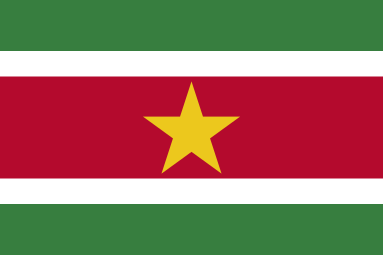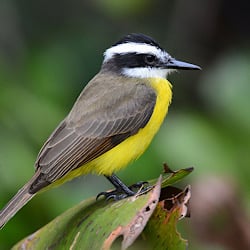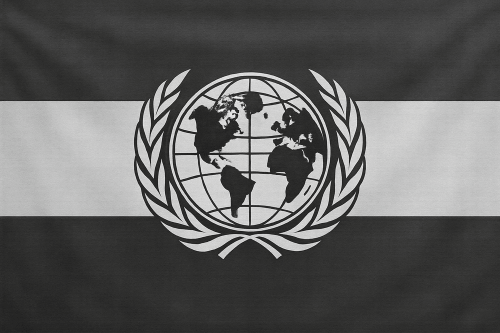This nation is in Vacation Mode for the next 3,199 turns. This nation cannot be attacked or traded with during that time.
| National Factbook |
| Flag: |

|
| Nation Name: |
Suriname |
| Leader Name: |
Jarrett |
| Currency: |

Surinamese Dollar |
| National Animal: |

Lesser Kiskadee |
| History: |
https://en.wikipedia.org/wiki/Suriname#History |
| Geography |
| Continent: |
South America |
| Land Area: |
331,765.44 sq. km |
| Terrain: |
Suriname is the smallest independent country in South America. Situated on the Guiana Shield, it lies mostly between latitudes 1° and 6°N, and longitudes 54° and 58°W. The country can be divided into two main geographic regions. The northern, lowland coastal area (roughly above the line Albina-Paranam-Wageningen) has been cultivated, and most of the population lives here. The southern part consists of tropical rainforest and sparsely inhabited savanna along the border with Brazil, covering about 80% of Suriname's land surface.
The two main mountain ranges are the Bakhuys Mountains and the Van Asch Van Wijck Mountains. Julianatop is the highest mountain in the country at 1,286 metres (4,219 ft) above sea level. Other mountains include Tafelberg at 1,026 metres (3,366 ft), Mount Kasikasima at 718 metres (2,356 ft), Goliathberg at 358 metres (1,175 ft) and Voltzberg at 240 metres (790 ft). |
| Highest Peak: |
Mt. Julianatop,
1,280 meters
|
| Lowest Valley: |
Unnamed location in the coastal plain,
-2 meters
|
| Climate: |
Lying 2 to 5 degrees north of the equator, Suriname has a very hot and wet tropical climate, and temperatures do not vary much throughout the year. Average relative humidity is between 80% and 90%. Its average temperature ranges from 29 to 34 degrees Celsius (84 to 93 degrees Fahrenheit). Due to the high humidity, actual temperatures are distorted and may therefore feel up to 6 degrees Celsius (11 degrees Fahrenheit) hotter than the recorded temperature. The year has two wet seasons, from April to August and from November to February. It also has two dry seasons, from August to November and February to April. |
| People & Society |
| Population: |
15,390,331 people |
| Demonym: |
Surinamer |
| Demonym Plural: |
Surinamese |
| Ethnic Groups: |
Afro-Surinamese (Creoles, Maroons) - 37.0%
East Indians - 27.0%
Javanese - 14.0% |
| Languages: |
Dutch (Official) - 60.0%
Sranan Tongo - 95.0%
English - 87.0% |
| Religions: |
Christianity - 48.4%
Hinduism - 22.3%
Islam - 13.9% |
| Health |
| Life Expectancy: |
71 years |
| Obesity: |
26.4% |
| Alcohol Users: |
0% |
| Tobacco Users: |
0% |
| Cannabis Users: |
0% |
| Hard Drug Users: |
0% |
| Economy |
| Description: |
Suriname was ranked the 124th safest investment destination in the world in the March 2011 Euromoney Country Risk rankings. It takes longer on average to register a new business in Suriname than virtually any other country in the world (694 days or about 99 weeks). |
| Average Yearly Income: |
$165.54 |
| Gross Domestic Product (GDP): |
$28,388,413,536.00 |
| GDP per Capita: |
$1,844.56 |
| Gross National Income (GNI): |
$23,808,551,785.00 |
| Industries: |
The backbone of the economy of Suriname is the export of aluminium oxide (alumina) and small amounts of aluminium produced from bauxite mined in the country. In 1999, the aluminium smelter at Paranam was closed and mining at Onverdacht ceased; however, alumina exports accounted for 72% of Suriname's estimated export earnings of US$496.6 million in 2001. Suriname's bauxite deposits have been among the world's richest.
Inexpensive power costs are Suriname's big advantage in the energy-intensive alumina and aluminium business. In the 1960s, the Aluminum Company of America (Alcoa) built the US$150-million Afobaka Dam for the production of hydroelectric energy. This created the Brokopondo Reservoir a 1,560 km² lake, one of the largest artificial lakes in the world. |
| Military |
| History: |
Suriname's National Armed Forces are composed of some 350,000 personnel, the majority of whom are deployed in the Army of Suriname.
The Armed Forces of Suriname have three branches: the Army, the Air Force, and the Navy. The President of the Republic, Jarrett, is the Supreme Commander-in-Chief of the Armed Forces (Opperbevelhebber van de Strijdkrachten). The President is assisted by the Minister of Defence. Beneath the President and Minister of Defence is the Commander of the Armed Forces (Bevelhebber van de Strijdkrachten). The Military Branches and regional Military Commands report to the Commander.
|
| Soldiers: |
48,491 |
| Tanks: |
0 |
| Aircraft: |
0 |
| Ships: |
117 |
| Missiles: |
3 |
| Nuclear Weapons: |
0 |
| Last Updated: 05/29/2020 01:02 am |



















